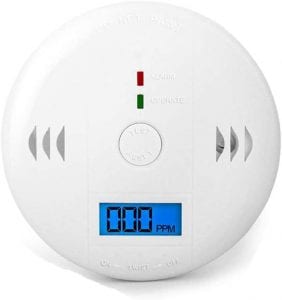The Best Carbon Monoxide Alarm

Our Review Process
Don't Waste Your Money is focused on helping you make the best purchasing decision. Our team of experts spends hundreds of hours analyzing, testing, and researching products so you don't have to. Learn more.
Our Picks For The Top Carbon Monoxide Alarms
- 1. WJZXTEK Wall Mounted Carbon Monoxide Alarm
- 2. Alert Pro Built-In Siren Carbon Monoxide Alarm
- 3. Kidde Nighthawk White Plug-In Carbon Monoxide Alarm
- 4. Google S3000BWES Nest White Carbon Monoxide Alarm
- 5. First Alert CO710 Digital Temp Carbon Monoxide Alarm
- 6. Kidde 21026065 Smoke & Carbon Monoxide Alarm
- 7. X-Sense White 10-Year Battery Carbon Monoxide Alarm
- 8. First Alert SCO501CN-3ST Battery Operated Smoke & Carbon Monoxide Alarm
- 9. Coreel LCD Display Carbon Monoxide Alarm
The digital display with backlight on this carbon monoxide alarm makes it easy to read. When carbon monoxide is detected, the alarm will sound at a loud 85 decibels to alert everyone in the home to head outside. The digital display will also flash, which is an excellent feature for those who are hard of hearing.
Most EconomicalThanks to the budget-friendly price tag on this carbon monoxide alarm, you'll be able to get one for several rooms in your home.
Once you reach 50 ppm, you'll get an alert within 60 to 90 minutes with this carbon monoxide alarm. Those alerts increase in time delay at higher ranges. If you reach 100 ppm, you'll get an alarm within 10 to 40 minutes. This detector is battery-powered, so you'll need to make sure you keep fresh batteries installed at all times.
Increasing FrequencyThis carbon monoxide alarm offers increasingly quick alerts as the carbon monoxide levels rise.
This carbon monoxide alarm doesn't just display current levels. You can also push a "peak level" button and see, at a glance, the top level that's been detected since the last time you reset or unplugged it. In addition to a test button, you'll see a blinking dot in the lower-right corner of the display to assure you that it's operating normally.
Easy Operation VerificationWith this carbon monoxide alarm, a blinking dot on the screen lets you know it's working.
Choose from a wired or battery-powered unit with this carbon monoxide alarm, which also detects the presence of smoke or fire. If it ever goes off unnecessarily, you can silence it using the smartphone app. You can also test it with one tap and get a full report of how it's operating.
Voice WarningThis carbon monoxide alarm gives you a voice alert when dangerous levels of CO are detected.
Buying Guide
Carbon monoxide is a silent danger that can lurk in any home. It can cause serious health problems and even death.
Unfortunately, carbon monoxide is both colorless and odorless, making it impossible to detect on your own. Carbon monoxide can be released by malfunctioning appliances. When this happens in a closed, unventilated space like a house, carbon monoxide can gradually build up so much that it becomes harmful.
The best way to detect the presence of carbon monoxide in an enclosed space is with the use of a carbon monoxide detector. There are three types of detectors: biomimetic, which uses a gel that changes color in the presence of CO; metal oxide semiconductor, which uses a silica chip; and electrochemical, which has electrodes in a chemical solution that sense changes in electrical currents due to elevated CO levels.
But you need a device that does more than detect the presence of carbon monoxide. It also needs to set off an alert when levels reach a certain threshold. The type of alert can be voice-based or as a beep, but whatever you choose, make sure you won’t miss it if the alarm does go off.
What to Look For
- Some carbon monoxide detectors are also smoke detectors to give your home full protection. However, if you go this route, make sure you’re getting the best of each of those devices in one. Otherwise, you’ll be better off investing in separate smoke and carbon monoxide detectors.
- For best results, place your detector close to the area where you sleep so that it will wake you up if it goes off while you’re sleeping. It should be about five feet from the floor. If your home has multiple stories, you need one for each story.
- Infrared photoelectric sensor-based detectors tend to do a better job without false alarms than the type that uses a gel or silica chip.
- It’s important to consider how your detector is powered. Some will plug into a power outlet, while others use a battery. Battery-powered detectors can fail if the battery goes bad, but they also will continue to work during power outages.
- How you’re alerted is important. Most alarms use a tone like a beep, although some are voice-based.
- It can also be nice to be able to check the current CO levels with the press of a button. Some detectors let you see the peak carbon monoxide levels within a recent timeframe. This will help you not just see what current levels are, but whether they’ve increased to dangerous levels in recent days or weeks.
More to Explore
Carbon monoxide is a serious risk. Each year, at least 430 people die from carbon monoxide poisoning, but about 50,000 people visit emergency rooms for carbon monoxide-related symptoms.
Although a carbon monoxide alarm is one of the best ways to detect the dangers before they become a problem, there are also some telltale signs. Unfortunately, the symptoms tend to be similar to many illnesses. You could experience headaches, nausea, fatigue, dizzy spells and/or just general confusion. The key area of concern is if more than one person in your household is suddenly experiencing one or more of those symptoms. But each person will react differently to carbon monoxide poisoning, so that’s not a reliable gauge.



















